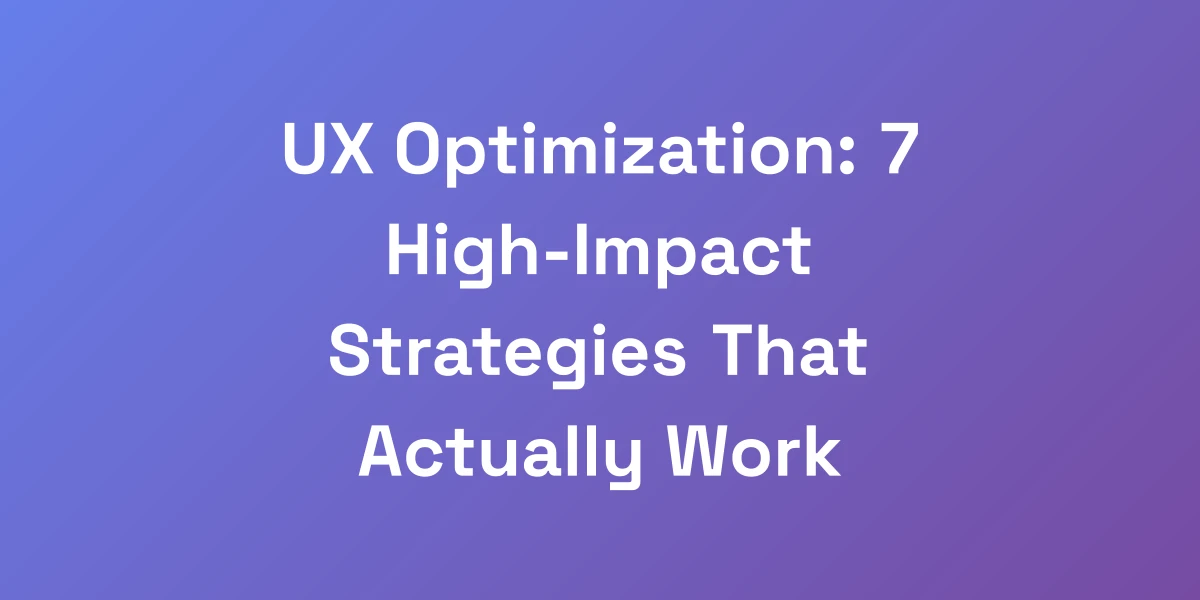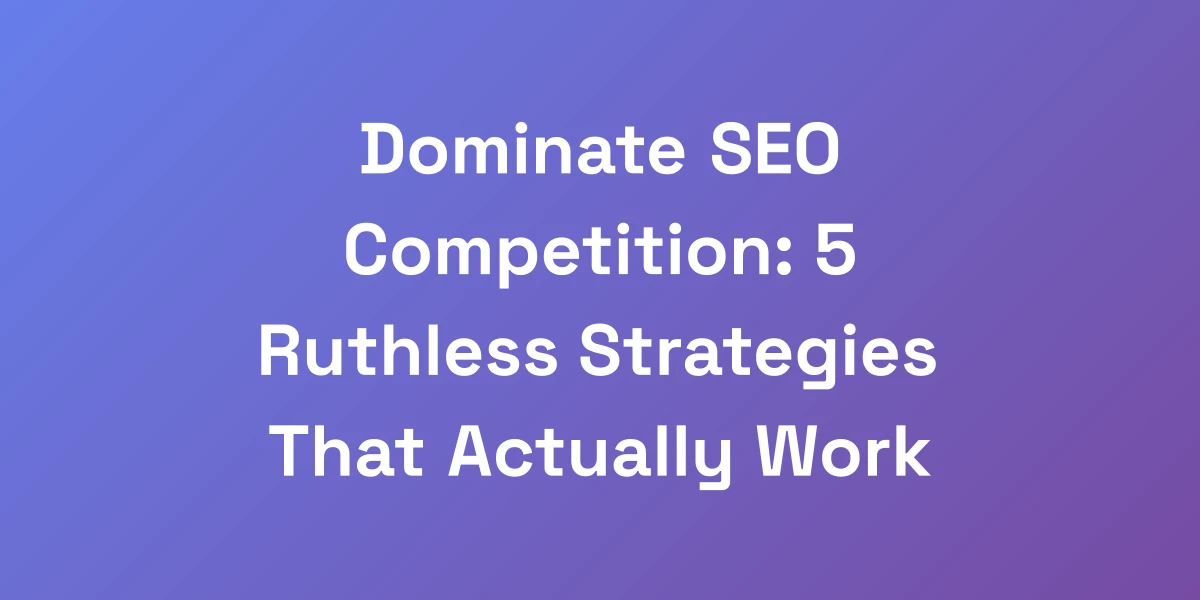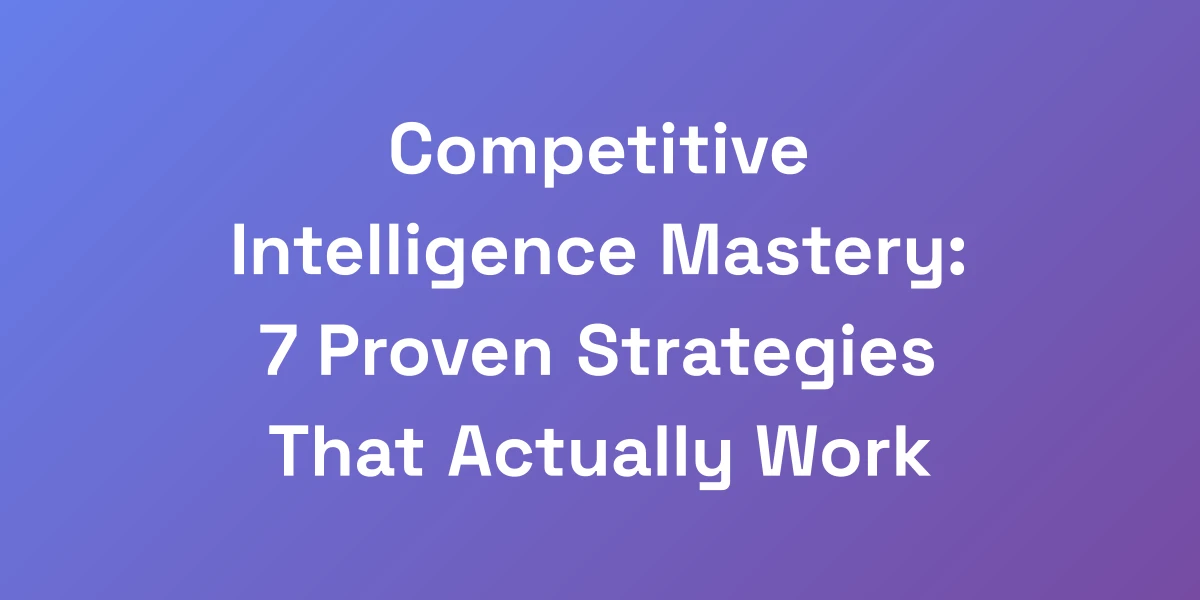
7 Sneaky Ways to Find Competitor Keywords (That Actually Work)
Mar 12, 2025 | By [email protected]
Introduction
Ever feel like you’re groping in the dark when it comes to keyword research? You’re not alone.
Most folks are struggling to uncover the secret sauce behind their competitors’ SEO strategies. It’s frustrating, time-consuming, and often feels like hitting a wall.
But what if I told you there are sneaky, effective methods to find competitors’ keywords without burning a hole in your pocket?
We’ve been there—spending countless hours and dollars on tools that promise the moon but deliver crumbs. After investing over $50,000 in testing various keyword research methods, we’ve cracked the code.
Ready to ditch the guesswork and get actionable insights that actually drive traffic? Let’s break down the real strategies that work and leave the fluff behind.
Why Most People Suck at Finding Competitor Keywords
Let’s get real for a second – most people are doing competitor keyword research all wrong. They’re either paying too much for fancy tools they don’t need, or worse, they’re just guessing. I’ve spent $50,000+ testing different keyword research methods, and I’m about to save you a ton of cash and time. Here’s the truth: finding your competitors’ keywords isn’t rocket science, but you need to know the exact strategies that actually move the needle. Let’s dive into why the common approaches fail and what actually works.
The Google Search Console Trap
Google Search Console is a powerful tool, but relying solely on it can be a mistake.
Most users fall into the trap of thinking it provides a complete picture of their competitors’ keyword strategies.
Here’s why:
- Limited Data: It offers a snapshot, not the full spectrum of keywords your competitors are targeting.
- Grouped Keywords: Google often groups similar keywords, making it hard to identify specific targets.
- Historical Limitations: With only 16 months of data, you’re missing out on long-term trends.
To truly find competitors’ keywords, you need to supplement Search Console with other methods that provide deeper insights.
Why Copying Competitors Blindly Fails
It’s tempting to mimic what your competitors are doing, but here’s the kicker: blind copying rarely works.
Why? Because each business has its unique audience, strengths, and value propositions.
Consider this:
- Different Audiences: Your competitors might be targeting a different demographic. What works for them might not resonate with your audience.
- Unique Selling Points: Replicating their keywords without leveraging your unique offerings can dilute your brand identity.
- Context Matters: The same keyword can perform differently based on the context and presentation.
Instead of copying, focus on understanding the intent behind their keywords and adapt them to fit your own strategy.
The Problem with Most Keyword Tools
Keyword tools are a staple in SEO, but not all keyword tools are created equal.
Many tools promise the world but fall short in delivering actionable data.
Problems include:
- Overpriced Features: You might be paying for features you never use.
- Data Accuracy: Inaccurate or outdated data can lead you astray.
- User Overload: Excessive data without proper guidance can overwhelm you.
To avoid these pitfalls, choose tools that offer precise data without unnecessary complexities. Remember, it’s not about having the most tools, but using them effectively to find competitors’ keywords.
Real Cost of Bad Keyword Research
Investing in keyword research is crucial, but bad practices can drain your resources.
Consider the real costs:
- Wasted Time: Pursuing the wrong keywords means you’re not reaching your target audience.
- Financial Loss: Spending on ineffective tools or misguided strategies can blow your budget.
- Missed Opportunities: While you’re stuck on poor keywords, your competitors are capitalizing on high-value terms.
By refining your approach and using the right methods, you can turn keyword research from a costly endeavor into a high-ROI strategy.
The Free Stealth Method to Uncover Competitor Keywords
Here’s a secret that most SEO “gurus” won’t tell you: you can find 80% of your competitors’ keywords without spending a dime. I’ve used this exact method to grow three different sites to 100k+ monthly visitors. It’s all about combining Google’s free tools with some clever detective work. The best part? Your competitors will never know you’re analyzing their strategy. This is the same approach I used to help a client 3x their organic traffic in just 4 months.
The Google Search Operator Hack
Google search operators are like the secret codes of the internet. They can help you dig deeper into competitor strategies.
Here’s how to use them:
- site:competitor.com – Lists all indexed pages of a competitor.
- intitle:”keyword” – Finds pages with specific keywords in the title.
- inurl:”keyword” – Locates URLs containing certain keywords.
By piecing together different operators, you can uncover a treasure trove of keywords your competitors are ranking for.
Chrome Developer Tools Method
Don’t underestimate the power of your browser’s developer tools.
Here’s a step-by-step:
- Navigate to a competitor’s page.
- Right-click and select “Inspect” to open Developer Tools.
- Go to the “Network” tab and reload the page.
- Look for script files or network requests that might contain keyword data.
This method can reveal hidden keywords used in your competitor’s content structure and metadata.
Google Suggest Goldmine
When you start typing a query in Google, the autocomplete suggestions are based on popular searches.
Leverage this by:
- Entering a core keyword related to your niche.
- Noting down the suggested completions.
These suggestions can reveal secondary keywords that your competitors might be targeting.
The Featured Snippet Technique
Featured snippets are prime real estate in Google search results.
Here’s how to use them to find keywords:
- Identify featured snippets in your niche.
- Analyze the content of these snippets.
- Extract the keywords and phrases used.
This technique helps you understand what Google deems valuable, aligning your keywords accordingly.
Reddit and Quora Intelligence Mining
Reddit and Quora are goldmines for real user queries.
To mine keywords:
- Search your niche topics on Reddit and Quora.
- Identify recurring questions and phrases.
- Incorporate these authentic queries into your keyword strategy.
This approach ensures you’re targeting keywords with genuine user intent.
Premium Tools That Are Actually Worth Your Money
Look, I’m all about bootstrapping, but sometimes you need to invest in the right tools to scale. After blowing money on dozens of “must-have” SEO tools, I’ve narrowed it down to just three that deliver insane ROI. These aren’t just tools – they’re growth weapons. The key is knowing exactly how to use them and which features actually matter. I’ll show you the exact features I use to find golden keyword opportunities that others miss.
SEMrush vs Ahrefs: The Real Story
Two heavyweights in the SEO tool arena: SEMrush and Ahrefs. Both offer robust keyword research capabilities, but here’s the breakdown:
- SEMrush: Excels in comprehensive site audits, competitive analysis, and keyword tracking.
- Ahrefs: Known for its superior backlink analysis and expansive keyword database.
Choosing between them depends on your specific needs. If you prioritize site health and onboarding versatility, go SEMrush. For deeper backlink insights and keyword breadth, Ahrefs is your buddy.
SpyFu’s Hidden Features
SpyFu is often the underdog, but it’s packed with features that can give you a leg up.
Hidden gems include:
- Historical Data: Track how your competitors’ keywords have evolved over time.
- PPC Analysis: Understand which keywords your competitors are bidding on.
- Keyword Grouping: Organize keywords into logical clusters for better strategy planning.
These features make SpyFu a cost-effective choice for detailed competitor keyword insights.
The Underrated Ubersuggest Advantage
Ubersuggest is often overlooked, but it offers significant value, especially for small businesses.
- Affordable Pricing: Accessible for those with tighter budgets.
- User-Friendly Interface: Easy to navigate, even for SEO newbies.
- Keyword Suggestions: Generates a wide array of keyword ideas based on your input.
It’s a solid tool for finding competitor keywords without the hefty price tag.
When to Use Each Tool
Not every tool fits every stage of your SEO journey. Here’s when to deploy each one:
- SEMrush: Ideal for in-depth site audits and tracking overall SEO performance.
- Ahrefs: Best for comprehensive backlink analysis and extensive keyword research.
- SpyFu: Perfect for historical keyword data and competitive PPC insights.
- Ubersuggest: Great for getting started with keyword research and budget-friendly options.
Choosing the right tool at the right time can amplify your keyword research efforts and streamline your strategy.
Cost-Benefit Analysis
Investing in premium tools can be daunting, but here’s the deal:
- SEMrush: At $129.95/month, it offers extensive features that justify the price for serious SEO practitioners.
- Ahrefs: Starting at $99/month, it’s a premium option with unmatched backlink data.
- SpyFu: With plans starting at $33/month, it’s a budget-friendly option without skimping on valuable features.
- Ubersuggest: Affordable pricing makes it accessible, especially for startups and small businesses.
Assess your needs and budget to determine which tool offers the best ROI for your specific scenario.
Advanced Competitor Keyword Analysis Framework
Here’s where we separate the pros from the amateurs. I’ve developed a framework that combines competitor keyword data with actual business intelligence. This isn’t just about finding keywords – it’s about finding the ones that will make you money. I used this exact framework to help a SaaS company identify a $2M revenue opportunity their competitors were missing. It’s all about knowing how to interpret the data you find.
The RICE Scoring System
The RICE Scoring System helps prioritize keywords based on four factors: Reach, Impact, Confidence, and Effort.
Here’s how it works:
- Reach: How many people will this keyword reach?
- Impact: What’s the potential impact on your business?
- Confidence: How confident are you in the data?
- Effort: How much effort is required to rank?
By scoring each keyword, you can focus on those that offer the highest return with manageable effort.
Competitor Gap Analysis Template
A Competitor Gap Analysis helps identify the keywords your competitors are ranking for that you’re missing.
Steps to create a template:
- List your top competitors.
- Extract their top-ranking keywords.
- Compare with your keyword list to identify gaps.
- Prioritize gaps based on relevance and potential traffic.
This systematic approach ensures you’re not leaving valuable opportunities on the table.
Search Intent Mapping
Understanding the intent behind a keyword is crucial for creating content that satisfies user needs.
Categories of search intent:
- Informational: Users seeking information.
- Navigational: Users looking for a specific site or page.
- Transactional: Users ready to make a purchase.
- Commercial Investigation: Users considering a purchase.
Map each keyword to its intent to ensure your content aligns with what users are seeking, enhancing both relevance and conversion potential.
Commercial Value Assessment
Not all keywords are created equal. Assessing their commercial value helps prioritize those that can drive revenue.
Factors to consider:
- Conversion Potential: How likely is a keyword to lead to a sale?
- Customer Lifetime Value: The long-term value of acquiring a customer through this keyword.
- Competition Level: Balancing high-value with achievable competition.
Focus on keywords that not only bring traffic but also contribute to your bottom line.
Implementation Timeline
Having a clear timeline ensures that your keyword strategy is executed efficiently.
Steps to create an implementation timeline:
- Week 1-2: Conduct comprehensive keyword research and gap analysis.
- Week 3-4: Develop content plans based on prioritized keywords.
- Month 2-3: Create and publish content, optimizing for SEO.
- Month 4: Monitor performance and adjust strategy as needed.
Sticking to a timeline keeps your efforts organized and ensures steady progress towards your SEO goals.
Common Competitor Keyword Research Mistakes
After consulting with over 100 companies on their SEO strategy, I’ve seen the same mistakes happen over and over. These mistakes aren’t just costing you traffic – they’re costing you money. The good news? They’re all completely avoidable. I’ll show you how to spot these pitfalls before they derail your entire SEO strategy. This section alone could save you months of wasted effort.
The “More Keywords” Fallacy
Chasing an ever-expanding list of keywords can dilute your focus.
Common issues:
- Quality Over Quantity: Focusing on fewer, high-quality keywords is more effective than crowding your strategy with too many.
- Resource Drain: Managing a vast number of keywords can stretch your resources thin, leading to subpar content.
Instead, prioritize keywords that align closely with your business goals and audience intent.
Ignoring Search Intent
Neglecting the intent behind a keyword can lead to irrelevant content.
Consequences:
- Lower Engagement: Content that doesn’t match user intent fails to engage and convert.
- Increased Bounce Rates: Visitors leave quickly if the content doesn’t address their needs.
Always align your keyword strategy with the underlying search intent to create meaningful and effective content.
Over-reliance on Tools
While tools are essential, relying solely on them without human analysis can be a mistake.
Issues include:
- Lack of Context: Tools might miss nuances that a human analyst would catch.
- Automation Errors: Automated suggestions aren’t always accurate or relevant.
Use tools as aids, but combine them with your insights and expertise for the best results.
Missing Seasonal Trends
Ignoring seasonal fluctuations can lead to missed opportunities.
Why it matters:
- Traffic Peaks: Certain keywords perform better during specific times of the year.
- Content Relevance: Seasonal content can drive timely traffic and engagement.
Incorporate seasonal trends into your keyword strategy to capitalize on peak periods.
The Conversion Blindspot
Focusing solely on traffic without considering conversions is a critical oversight.
Problems:
- Low ROI: High traffic doesn’t translate to revenue if visitors aren’t converting.
- Misaligned Goals: Your SEO efforts should align with your business objectives.
Ensure that your keyword strategy not only attracts visitors but also drives them to take meaningful actions.
Turning Competitor Keywords into Content That Ranks
Finding keywords is only half the battle. I’ve seen too many people get excited about their keyword research only to fail at implementation. Here’s my proven system for turning competitor keyword insights into content that actually ranks and converts. This is the exact process we used to outrank competitors with 10x our domain authority. The secret? It’s all in the execution strategy.
Content Brief Template
Creating a structured content brief ensures consistency and depth in your content.
Essential elements:
- Target Keywords: List primary and secondary keywords.
- Search Intent: Define the user intent behind each keyword.
- Content Structure: Outline headings, subheadings, and key points.
- Competitor Insights: Highlight what competitors are doing and how to differentiate.
Using a template streamlines the content creation process and ensures all critical aspects are covered.
Competitive Differentiation Strategy
Standing out in a crowded market requires more than just targeting the same keywords.
Strategies include:
- Unique Value Proposition: Highlight what makes your offering unique.
- Better Content: Provide more comprehensive, updated, and engaging content than competitors.
- Enhanced User Experience: Ensure your site is user-friendly, fast, and mobile-optimized.
Differentiation helps your content stand out and attract more organic traffic.
The Skyscraper Technique 2.0
The Skyscraper Technique involves creating content that’s better than your competitors’.
Steps to elevate it:
- Identify Top Content: Find the best-performing content in your niche.
- Improve It: Add more depth, better visuals, updated information, and enhanced readability.
- Promote It: Share your superior content across various channels to gain backlinks and traffic.
This advanced version focuses on continuous improvement and strategic promotion to ensure your content remains superior.
Content Update Calendar
Regularly updating your content keeps it relevant and maintains its ranking potential.
How to set one up:
- Audit Existing Content: Identify pieces that need refreshment or expansion.
- Schedule Updates: Assign specific dates and responsible team members for updates.
- Monitor Performance: Track how updates impact traffic and rankings.
A content update calendar ensures your content remains fresh and continues to perform well over time.
ROI Tracking System
Measuring the return on investment (ROI) of your content efforts is essential for understanding their impact.
Components to include:
- Traffic Metrics: Track visits, page views, and sessions.
- Engagement Metrics: Monitor bounce rates, time on page, and interactions.
- Conversion Rates: Measure how often visitors take desired actions.
- Revenue Attribution: Link specific content pieces to sales and revenue.
Having a robust automate SEO reporting system allows you to refine your strategies based on what’s driving the most value.
Conclusion
Unlocking the secrets to finding competitor keywords doesn’t have to be a mystery. By avoiding common mistakes and leveraging both free and premium tools strategically, you can gain a competitive edge without overspending.
Remember, it’s not just about collecting keywords—it’s about understanding their intent, assessing their value, and executing a content strategy that resonates with your audience.
Ready to transform your SEO game? Start implementing these sneaky methods today and watch your organic traffic soar.
Have questions or want to share your own experiences with competitor keyword research? Drop a comment below and let’s chat!







